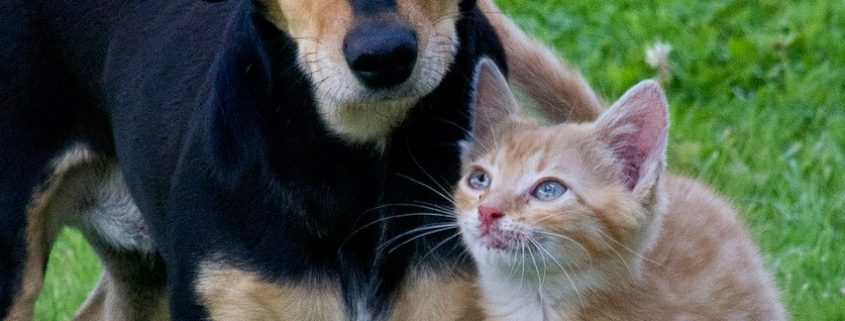Ask Crystal: Dogs Chasing Cats
Welcome to “Ask Crystal,” where you can ask your pet behavior questions! You can submit your question for Crystal at the bottom of the page!

Dear Crystal,
My dog is a sweet dog but she wants to corner my cats. She is 8 and the cats will not come around her.
Sincerely,
Cat Chaser
Dear Cat,
People have dreams of the Disney version of cats and dogs living in their homes being best friends and snuggling up together. While that can happen, it’s important to remember that all animals are individuals. The animals previous experience and how we introduce them can also have a big impact on how they eventually end up getting along.
Why do dogs chase cats in the first place? Chasing is self-reinforcing for dogs. That is because chasing is an instinctual response in dogs. They would have needed to chase things down to eat or maybe they are a breed that chasing is part of their job they were bred to do. Sometimes the dog is trying to play with the cat rather than treating it like prey. Running and chasing is a big part of playing for dogs.
If your cats have never lived with dogs before, they are possibly afraid of them. This means when they encounter a dog they will likely run or if they are cornered, they may behave aggressively. If the cat is fearful in general, she is more likely to choose running away from the dog or anything she is not familiar with. Fearful cats tend to take much longer to introduce to dogs for the first time.
You also want to make sure that your dog’s needs are being met in regards to exercise. If she is playing with the cats because she has too much energy, we can help the situation by providing other means of expelling that energy. She is on the older side so that seems a little less likely than for a younger dog but it can’t hurt to see if exercising her more calms her down a little.
Work on setting up a management plan. It is critical that the dog be prevented from practicing the behavior while you are working on changing her behavior. The more she is allowed to act in this manner, the harder and longer it will be to change it. First, let’s look at how we can manage the environment.
You may want to go back to some form of separation like you did in the beginning when you first introduced the dog to the cats. Have a room where you can place the cats that has food, water and litter. I am sure they won’t love it but it won’t be forever. This way the dog and cats are only interacting when you are working with them in a very intentional way.
 Cats need places that are up high so that they can feel safe and watch what is going on. Offer lots of high up places, hiding places and escape routes that the dog can’t access. I have seen people create little tunnels behind furniture or down hallways so the cats can safely get away when they want to. In my cat room, I have a baby gate with a tiny cat door so the dog can’t get in.
Cats need places that are up high so that they can feel safe and watch what is going on. Offer lots of high up places, hiding places and escape routes that the dog can’t access. I have seen people create little tunnels behind furniture or down hallways so the cats can safely get away when they want to. In my cat room, I have a baby gate with a tiny cat door so the dog can’t get in.
Next think about ways we can manage the movement of the dog. The dog should be dragging a leash around anytime she is in the same room with the cats while you are working on this issue. This way until you have her responding consistently to cues, you can step on the leash and prevent any cornering or chasing. I would also suggest that she is crate trained so that you can have her in a crate while the cats walk around. A training tether would also be helpful to keep her in one spot while you are working with her around the cats. You can attach it to a heavy piece of furniture, door or hold it in your hand.
There are some training cues that I recommend your dog knows to help redirect her. The idea here is to catch her when we see her focusing on the cat or about to chase and call her back to us to interrupt the behavior. Staring at the cats is usually the first clue that the dog is about to start the chase. A positive interrupter is a phrase that you condition the dog to so that as soon as she hears it, she comes right over to you. Leave it means leave whatever you are going towards or have and come back over to me.
The key to having success with this type of training is to teach it outside of the context of the cat chasing behavior first. We can’t expect her to be able to learn at that point. The other important thing is to be sure that you continue to reinforce her leaving and coming back to you with treats at least occasionally. Remember that you are competing with the motivation to engage in an activity that she finds really fun so you need to give her a reason to want to listen to you!
You could start by calling her away from the cat in a carrier. Don’t allow her to get too close at first and that will make it easier for her. Another great place to practice is when the cats are behind a baby gate. We want to increase the difficulty slowly so that the dog can be successful.
Another important aspect of the training is to teach the dog a cue which will help her to behave calmly in the presence of the cats. Again, teaching this outside of the context of the cats first is really critical. A stationary cue such as stay or place will help keep her in a particular spot while the cats walk around. In this way we can reward her behaving calmly in the presence of the cats.
If the cat is afraid of the dog, we can work on changing the animal’s emotional response to her. We do this by pairing the presence of the dog with yummy treats like tuna or chicken. We always work at the distance where the animal feels comfortable so let them dictate where they want to be and how slow or fast the training will go. For a simplistic example, if you have the dog at the baby gate, someone else would be feeding the cat treats for looking at the dog. Do the same training with the dog so we are working on changing the emotional response of both animals.
The extent of the training and management is really going to depend on the individual animals. If you need help formulating a plan, locate a Certified Professional Dog Trainer here: https://www.ccpdt.org/dog-owners/certified-dog-trainer-directory/
You may never get to a point where the dog and the cats are best friends but hopefully you can reach some sort of peace or agreement between them so that they all can feel relaxed sharing the same space. Good luck!
Until next time,
Crystal







